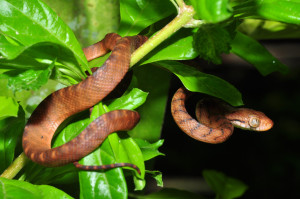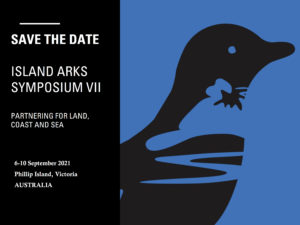The US Department of Agriculture will soon be deploying dead mice injected with poison to the Anderson Air Force Base. The poison, a sedative, is deadly to Guam’s brown tree snake. The snake, known to kill birds, is considered a threat because it could hitch a ride on Air Force planes to Hawaii.

© 2012 Pavel Kirillov, used under a Creative Commons Attribution-ShareAlike license: http://creativecommons.org/licenses/by-sa/3.0/
In a recent interview with ABC reporter Heather Jarvis, assistant state director of US Department of Agriculture’s Wildlife Services in Hawaii, Guam and the Pacific Islands, Daniel Vice, said the snakes are a serious threat to wildlife anywhere they establish and thus merit the amount of work involved in the mice air drop. Listen to the full interview online.
About the Brown Tree Snake
In the late 1940s the brown tree snake (Boiga irregularis) was accidentally introduced to Guam, likely from Solomon Islands, where it has significantly damaged the local ecology and economy. The snake is native to Australia, eastern Indonesia, and Melanesia.
Further reading:
- US plan to control Guam’s snake population with toxic mice angers Peta
- No Escape From Guam: Stopping the Spread of the Brown Tree Snake (PDF)
- Brown Treesnake Control: Economy of Scales (PDF)
- Brown Treesnake Research at the National Wildlife Research Centre
- USDA Wildlife Damage Management: Brown Tree Snake
Image: ‘Brown Tree Snake‘ © 2012 Pavel Kirillov, used under a Creative Commons Attribution-ShareAlike license: http://creativecommons.org/licenses/by-sa/3.0/


The activity of the toxicant is by no means specific to the brown treesnake and its affects would not be considered “sedative” in this case. Please research your facts before you make such claims, as others may utilize the same toxicant believing that non-target organisms are safe. Additionally, there are other effective methods currently available to control the brown treesnake that are underutilized. Aerial application is an expensive and risky method when there are other methods available. Previous aerial application on Guam does not support this method as the best choice. Something else to consider, if Wildlife Services wants to protect other areas from the brown treesnake, they should inspect passenger baggage. They do not, but they do spend millions of US taxpayer dollars to inspect cargo, household goods, and the exterior of aircraft. We know that people are interested in moving animals around as pets. Please ask Wildlife Services why they do not inspect passenger baggage and what risk they have determined is associated with movement of the snake via passenger baggage. There are many accounts in the literature and press of humans intentionally moving snakes and other animals in their baggage. Why spend so much taxpayer money when a critical gap in dispersal of the brown treesnake is being ignored?
A key purpose of the Island Arks blog is to bring to attention, contemporary island management challenges and opportunities. Control programs for non-indigenous species on islands (and elsewhere) are often controversial and can be characterised by strongly polarised views amongst different sectors of the island community. For this reason, we have provided ‘Further reading’ as part of the post to assist the audience in developing an informed opinion. We strongly support robust bio-security frameworks for islands as key tools in reducing threats to biodiversity, primary production and human health on islands.
In your reply, please correct the statement: “The poison, a sedative, is deadly only to Guam’s brown tree snake.” It is critically important that we humbly strive for accuracy when presenting information for the public’s understanding of these very important issues.
Thank you for your comments Alex. We have edited the statement to read: “The poison, a sedative, is deadly to Guam’s brown tree snake.”
Thank you!
Strong feelings regarding any issue necessitate the importance of working with facts, validating sources, and being sure that we are referencing real data (when available), comprehensive and objective sources, acknowledging when we are not, and considering uncertainties in our conclusions when we are not. Yes, let’s get all the accurate information that we can about this proposed activity and see what picture emerges. Let’s do our best to make informed decisions.